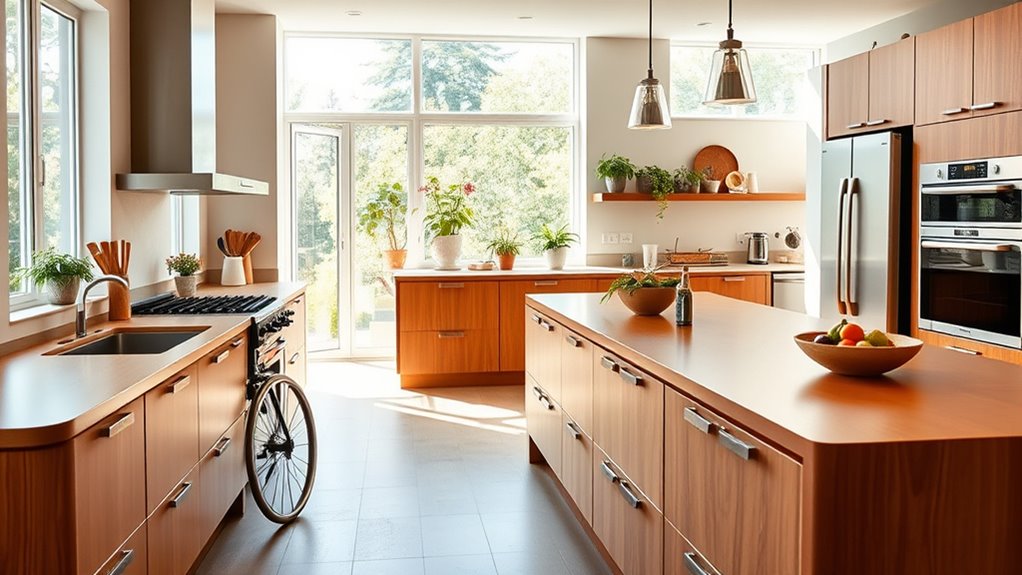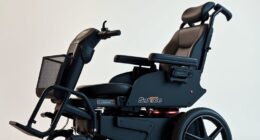Designing a welcoming, wheelchair-friendly kitchen balances accessibility with style by choosing warm tones, textured surfaces, and streamlined cabinetry that minimize clutter. Incorporate open spaces at least 36 inches wide for easy navigation, and select counters around 30 inches high with open underneath areas for comfortable use. Good lighting, thoughtful storage solutions, and visual contrast enhance safety while maintaining a cozy, inviting atmosphere. Keep exploring to discover more tips for creating an accessible yet attractive kitchen.
Key Takeaways
- Incorporate warm tones, textured surfaces, and stylish hardware to create a welcoming, homey atmosphere.
- Use streamlined cabinetry with open shelving or glass-front designs to reduce clutter and add visual interest.
- Ensure smooth, open layouts with at least 36-inch wide pathways for easy wheelchair navigation.
- Install adjustable-height counters and open space beneath sinks and cooktops for accessibility and legroom.
- Use layered lighting, including under-cabinet and ambient fixtures, to enhance safety and maintain a cozy, inviting ambiance.

Designing a kitchen that welcomes wheelchairs guarantees everyone can cook and move comfortably. You want your space to be functional and inviting, not clinical or overly specialized. Achieving this balance starts with thoughtful layout choices that prioritize accessibility without sacrificing style. When planning your kitchen, consider the flow of movement. You should be able to navigate seamlessly from appliances to countertops and storage areas. To do this, aim for open spaces—at least 36 inches wide—so you can turn easily in your wheelchair without feeling cramped. Avoid clutter and obstructions that could hinder your mobility or pose safety hazards. Instead, opt for clean, streamlined surfaces that allow for easy cleaning and maintenance. Incorporating color contrast can also help with visibility and safety in your space.
Counter height is vital. Standard counters can be too high for wheelchair users, making it difficult to reach or work comfortably. Instead, select counters that are lower—around 30 inches—to allow you to sit comfortably and reach everything in your workspace. Consider installing adjustable-height counters or work surfaces, giving you flexibility depending on your needs. Incorporate open space underneath sinks and cooktops to allow for legroom and ease of access. This not only makes the kitchen more functional but also creates a welcoming environment that doesn’t feel clinical or intimidating. When choosing cabinetry, prioritize pull-out shelves and drawers over traditional cabinets with doors. This way, you can access items more easily without bending or stretching excessively. Keep frequently used items within easy reach—about waist height—to minimize unnecessary movement and strain.
Lighting is another key aspect. Proper illumination ensures safety and ease of use. Use bright, evenly distributed lighting that eliminates shadows, helping you see clearly while preparing meals. Under-cabinet lighting can be particularly effective, providing direct light on work surfaces without cluttering the space. The materials and finishes you choose should complement your home’s aesthetic and avoid overly sterile or institutional looks. Warm tones, textured surfaces, and stylish hardware can make your kitchen feel cozy and inviting. Incorporate elements like open shelving or glass-front cabinets to break up the visual weight of cabinetry and add a decorative touch.
Ultimately, a welcoming wheelchair-accessible kitchen blends form and function seamlessly. By focusing on practical layout, adjustable features, and thoughtful design details, you create a space that’s easy to navigate and beautiful to behold. You deserve a kitchen that empowers you to cook, socialize, and enjoy your home without feeling restricted or uncomfortable. Prioritize your needs, add your personal style, and you’ll craft a kitchen that truly welcomes everyone.
Frequently Asked Questions
How Can I Improve Kitchen Lighting for Better Visibility?
To improve kitchen lighting for better visibility, you should install layered lighting. Use bright overhead LEDs for general illumination, task lights under cabinets for countertops, and focused lighting over the stove and sink. Opt for dimmable fixtures to adjust brightness as needed. Keep light colors neutral to reflect more light, and make sure switches are easily accessible. Regularly clean light fixtures to maintain maximum brightness and create a well-lit, functional space.
What Are Affordable Options for Wheelchair-Accessible Kitchen Modifications?
You can transform your kitchen with affordable modifications that make a huge difference. Install pull-down shelves or open cabinets for easy access, and opt for a wheelchair-friendly sink and countertop height. Use removable or flexible hardware to avoid clutter, and add non-slip mats for safety. Repurposing existing furniture and choosing budget-friendly accessories can further enhance accessibility without breaking the bank, creating a welcoming space that’s both functional and stylish.
How Do I Choose Durable Materials for Wheelchair-Friendly Kitchens?
To choose durable materials for your wheelchair-friendly kitchen, prioritize options like quartz countertops, stainless steel, and tile flooring, which resist scratches, stains, and wear. Avoid softer surfaces like laminate or vinyl that may dent or tear easily. Look for materials with high durability ratings and easy maintenance. Consider your daily use, spills, and cleaning needs, then select sturdy, low-maintenance options that will stand up to regular use without looking worn.
Are There Portable Solutions to Make Existing Kitchens More Accessible?
Did you know over 60% of wheelchair users seek portable solutions for better accessibility? You can add removable ramps, like foldable options, to door thresholds or steps, making your kitchen more accessible without permanent changes. Consider adjustable-height countertops on mobile bases or portable sink risers. These easy-to-move modifications allow you to customize your space quickly, ensuring safety and comfort without sacrificing style or functionality.
How Can I Personalize a Wheelchair-Friendly Kitchen to Match My Style?
You can personalize your wheelchair-friendly kitchen by choosing colors, finishes, and decor that reflect your style. Incorporate stylish cabinetry, unique backsplashes, and decorative lighting to add personality. Use accessories like colorful rugs, trendy storage containers, and artistic wall art to make the space inviting. Select appliances with sleek designs that match your aesthetic. By combining functionality with your favorite design elements, your kitchen becomes both accessible and uniquely yours.
Conclusion
Creating a kitchen that welcomes a wheelchair shouldn’t feel like a design compromise. Instead, think of it as blending practicality with warmth—like choosing cozy, accessible countertops over sterile, clinical setups. When your space balances comfort and function, it becomes a place where independence thrives, and everyone feels at home. After all, a welcoming kitchen isn’t just about accessibility; it’s about making everyday moments meaningful and effortless for everyone who steps inside.









